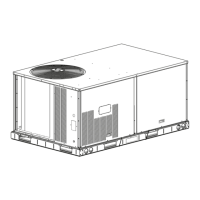54
Proceed as follows to inspect and prepare the unit for initial
start-up:
1. Remove all access panels.
2. Read and follow instructions on all WARNING, CAU-
TION, and INFORMATION labels attached to, or shipped
with, unit.
3. Make the following inspections:
a. Inspect for shipping and handling damages such as bro-
ken lines, loose parts, or disconnected wires, etc.
b. Inspect for oil at all refrigerant tubing connections and
on unit base. Detecting oil generally indicates a refriger-
ant leak. Leak-test all refrigerant tubing connections
using electronic leak detector, halide torch, or liquid-
soap solution.
c. Inspect all field-wiring and factory-wiring connections.
Be sure that connections are completed and tight. Be
sure that wires are not in contact with refrigerant tubing
or sharp edges.
d. Inspect coil fins. If damaged during shipping and han-
dling, carefully straighten fins with a fin comb.
4. Verify the following conditions:
a. Make sure that condenser-fan blades are correctly posi-
tioned in fan orifice. See Condenser-Fan Adjustment on
page 17 for more details.
b. Make sure that air filter(s) is in place.
c. Make sure that condensate drain trap is filled with water
to ensure proper drainage.
d. Make sure that all tools and miscellaneous loose parts
have been removed.
START-UP, GENERAL
Unit Preparation
Make sure that unit has been installed in accordance with installa-
tion instructions and applicable codes.
In addition to the base unit start-up (unit with electro-
mechanical control), there are a few steps needed to properly
start-up units with optional direct digital controls (DDC). The
DDC’s Service Test function should be used to assist in the
base unit start-up and also allows verification of output opera-
tion. Controller configuration is also part of start-up. This is es-
pecially important when field accessories have been added to
the unit. The factory pre-configures options installed at the fac-
tory. There may also be additional installation steps or inspec-
tion required during the start-up process.
Additional Installation/Inspection
Inspect the field-installed accessories for proper installation,
making note of which ones do or do not require configuration
changes. Inspect the DDC Alarms for initial insight to any po-
tential issues. Refer to the Controls, Start-up, Operation and
Troubleshooting Instructions manual for the specific DDC. In-
spect the SAT sensor for relocation as intended during installa-
tion. Inspect special wiring as directed below.
Return-Air Filters
Ensure correct filters are installed in unit (see Appendix B —
Physical Data on page 57). Do not operate unit without return-
air filters.
Outdoor-Air Inlet Screens
Outdoor-air inlet screen must be in place before operating unit.
Compressor Mounting
Compressors are internally spring mounted. Do not loosen or
remove compressor hold down bolts.
Internal Wiring
Check all electrical connections in unit control boxes. Tighten
as required.
Refrigerant Service Ports
Each unit system has two 1/4 in. SAE flare (with check valves)
service ports: one on the suction line, and one on the compressor
discharge line. Be sure that caps on the ports are tight.
Compressor Rotation
On 3-phase units with scroll compressors, it is important to be cer-
tain compressor is rotating in the proper direction. To determine
whether or not compressor is rotating in the proper direction:
1. Connect service gauges to suction and discharge pressure
fittings.
2. Energize the compressor.
3. The suction pressure should drop and the discharge pres-
sure should rise, as is normal on any start-up.
If the suction pressure does not drop and the discharge pressure
does not rise to normal levels:
1. Note that the evaporator fan is probably also rotating in
the wrong direction.
2. Turn off power to the unit and install lockout tag.
3. Reverse any 2 of the unit power leads.
4. Re-energize to the compressor. Check pressures.
The suction and discharge pressure levels should now move to
their normal start-up levels.
NOTE: When the compressor is rotating in the wrong direc-
tion, the unit will make an elevated level of noise and will not
provide cooling.
Refrigerant Service Ports
Each system has two 1/4 in. SAE flare (with check valves) service
ports: one on the suction line, and one on the compressor dis-
charge line. Be sure that caps on the ports are tight.
WARNING
ELECTRICAL OPERATION HAZARD
Failure to follow this warning could result in personal injury or
death.
The unit must be electrically grounded in accordance with
local codes and NEC ANSI/NFPA 70 (American National
Standards Institute/National Fire Protection Association).
CAUTION
EQUIPMENT DAMAGE HAZARD
Failure to follow this caution can result in premature wear and
damage to equipment.
Scroll compressors can only compress refrigerant if
rotating in the right direction. Reverse rotation for
extended times can result in internal damage to the
compressor. Scroll compressors are sealed units and
cannot be repaired on site location.

